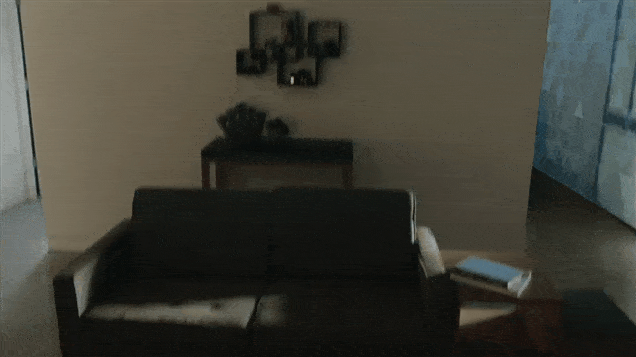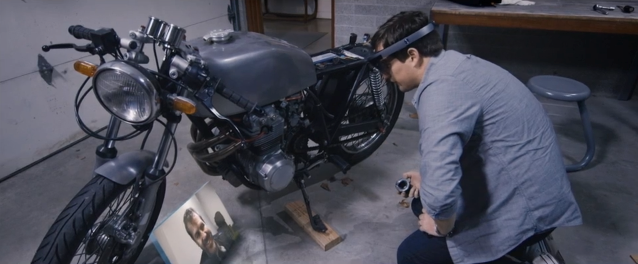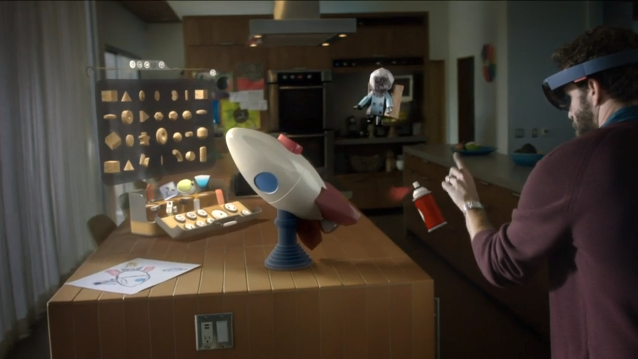The next frontier of computing seems, fairly inevitably, the space directly in front of our eye holes. Never mind that Google Glass washed out (for now), or that Oculus Rift is still a niche within a niche. Our wrists are being colonised. Our faces are next. And Microsoft, of all the players, might be the conquistador.
Microsoft’s Project HoloLens seems, at first, like something out of a bad advertisement for the future. Its promises are variations of “you’ll see and interact with things that aren’t there,” be it a fully formed Minecraft set-up or a giant screen to watch your Netflix on. It feels like one of those impossible visions of the future, one you look at with the condescending wisdom of someone who’s been let down before. You can see the actual real-life demo here:
Or if you love Minecraft and glossier demos and GIFs, here’s this:

Cool fantasy. And yet! Project HoloLens is far enough along that reporters were able to try it out themselves today. Developers will have access to it this spring. It will even, according to Microsoft, be deployed to help command the Mars rover later this year. In our own hands on with it, Sean thought it was “awesome” despite still being very much a prototype. If it’s not fully baked, it’s at least developing a healthy crust.
It’s an impressive technological feat. No argument here. But it doesn’t answer two important questions: Does anyone want a faceputer to begin with? And if so, do they really want Microsoft’s?
A Computer for Every Face
If you fully embrace a future wherein you experience the world at least some of the time through a technological remove that literally shields your eyes from anyone who would dare make contact with them while you augment your reality beyond recognition, move along to the next section! And godspeed, friend, I admire your conviction.
If, however, you have reservations, even if you can’t quite articulate them beyond a slightly skeezed-out feeling, or a suspicion that we’ve been down this road before, the good news is that you’re probably at least partly right on both counts. It’s unquestionably amazing, on a human ingenuity level, that we live in a world where we can put on a pair of space goggles and turn our mudrooms into holodecks. And the announcement of such a thing isn’t a total surprise. But… do enough people really want to use it? Or have any idea of what they might use it for? If 3D TV was too much of a distraction from a plain flat screen, is anyone really clamouring for the alteration of our entire visible world?
I suspect not, at least not in the current Darth Helmet-ish form factors that Oculus Rift (whose virtual reality chops are substantively different from Microsoft’s augmented reality, but same gist) and Samsung’s Gear VR employ. Big bulky things that are embarrassing to wear in the privacy of one’s own nerd pit, much less out in the sunlight. Even Google Glass, which offers a stripped down version of this same digitally altered state, was too, er, in your face to find success.
Augmented reality in general still feels like something we’re doing because we can. Without any thought to why we would, or the detailed specifics of how it fits into a normal, well-adjusted life. It’s probably not worth getting too riled up about HoloLens in general, because it doesn’t seem likely that to grace many faces any time soon.
Someday, though, something like it very well may. The technologies Microsoft showed today will likely be available in a delivery system that looks indistinguishable from an actual pair of glasses. No barrier to entry, no alienating bulk. And when that day comes, is it Microsoft’s (augmented) world you’ll be living in?
Killer Apps, Open Platform
It could be! The only real competition right now — especially if you allow that Oculus Rift is a different sort of animal — is a Google-backed company called Magic Leap, which so far has only offered teases and hints about what it’s capable of. They’re compelling, as far as teases and hints go:

But even if Magic Leap is as far along as HoloLens — or even a bit farther, who knows! — it will launch without anything approaching Microsoft’s scale. HoloLens is just one device born out of Windows Holographic, the umbrella under which the company’s augmented reality ambitions live. Windows Holographic, crucially, will be an open platform, meaning any and all can build future-goggles that fit in with its vision.
And they might! They might because all of this is “holographic” magic is baked into Windows 10, which means that literally any Windows 10 app could potentially float in the air in front of you while you poke and prod it into submission. It’s instant ecosystem, just add code.
On top of which, Microsoft already has two of its own in-demand apps ready to go. Building a Minecraft world in your living room sounds incredible. Having a Skype conversation where it looks like the person is floating in front of you is mid-tier Star Wars stuff. Magic Leap sounds like it will have plenty of games and experiences all it own, but it’s hard to imagine what could compete against the full weight of Windows.

If anyone can make augmented reality happen in a meaningful way, it might just be Microsoft. It’s a strange thought, after the gung-ho future swings and misses of things like Windows 8 and Surface RT. But it’s probably no stranger than a window to another world, perched on your nose, mere inches from your brain, showing you a 8-bit, candy-coloured castle of your own design.
